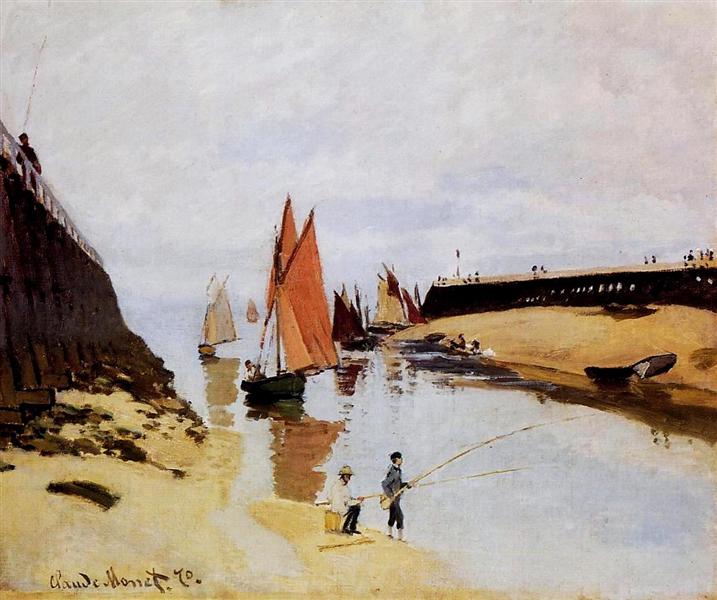Description
The work "Entrance to the port of Trouville" by Claude Monet, painted in 1870, represents an outstanding example of impressionism, an artistic movement that Monet himself helped define and popularize. This oil on canvas captures the maritime scene with a particular approach in light, color and atmosphere, characteristics that are fundamental in the artist's work.
Observing the painting, The first thing that attracts attention is the luminosity that emanates from the composition. Monet has achieved masterful use of blue and green tones, ranging from the intense reflections of water to the soft nuances of heaven, suggesting a sunny day. The surface of the water is full of movement, with waves that seem to vibrate and dance, reflecting the clouds that overcome it. This representation of water is a recurring theme in the work of Monet, who was fascinated by the way the light is reflected and refracted on the aquatic surface.
The structure of the paint consists of several ships that are anchored in the port, with their extended candles that add interest and dynamism to the scene. The presence of vessels, with their upright masts, serves to contrast with the softer and softest background of the coastal landscape. This duality between the solid and the ephemeral is a constant in the work of Monet, who knew how to capture the fleeting essence of light and time. The port of Trouville, a popular tourist destination in French Normandy, was known for its beaches and fishing activity, which Monet knew how to interpret through its unique vision.
In the plasticity of the paint, you can see a technique of loose and fast brushstrokes, which confers a rich texture and a sensation of immediacy. This is characteristic of the impressionist style, where the artist seeks to capture the visual impression of a specific moment instead of creating a detailed and finished portrait of reality. Visible brushstrokes suggest a sense of movement and change, in tune with the always variable nature of the landscape.
While there are no prominent human figures in the painting, The presence of the port and ships evokes the vibrant life that surrounded this place. The absence of individual characters reinforces the idea that Monet's main focus is the landscape itself and its interaction with light, reflecting a dogma of the impressionists who prioritized the environment on conventional narrative. However, it is possible that Monet wanted to insinuate, through subtle elements, the social and cultural life of the port, usual in his works where humans are portrayed as an integral part of the natural landscape.
Monet painted this work in a period in which his style was evolving towards what will later be recognized as pure impressionism. This technique incorporates an exhaustive study of light and color, at a time when outdoor painting gained popularity. "Entrance to the port of Truville" is a manifestation of this trend, where the painter, like other impressionists, sought to break the academic traditions of the art of his time.
In summary, "entrance to the port of Truville" not only represents the mastery of Monet in the representation of the landscape and the luminosity, but also reflects the essence of impressionism: an approach to visual perception and capture of the fleeting moment. The work is a testimony of Monet's unmatched talent and its ability to transform a simple port into a color and light celebration, which continues to resonate with the spectators until today.
KUADROS ©, a famous paint on your wall.
Hand-made oil painting reproductions, with the quality of professional artists and the distinctive seal of KUADROS ©.
Reproduction service paintings With a guarantee of satisfaction. If you are not completely satisfied with the replica of your painting, we refund your money 100%.

